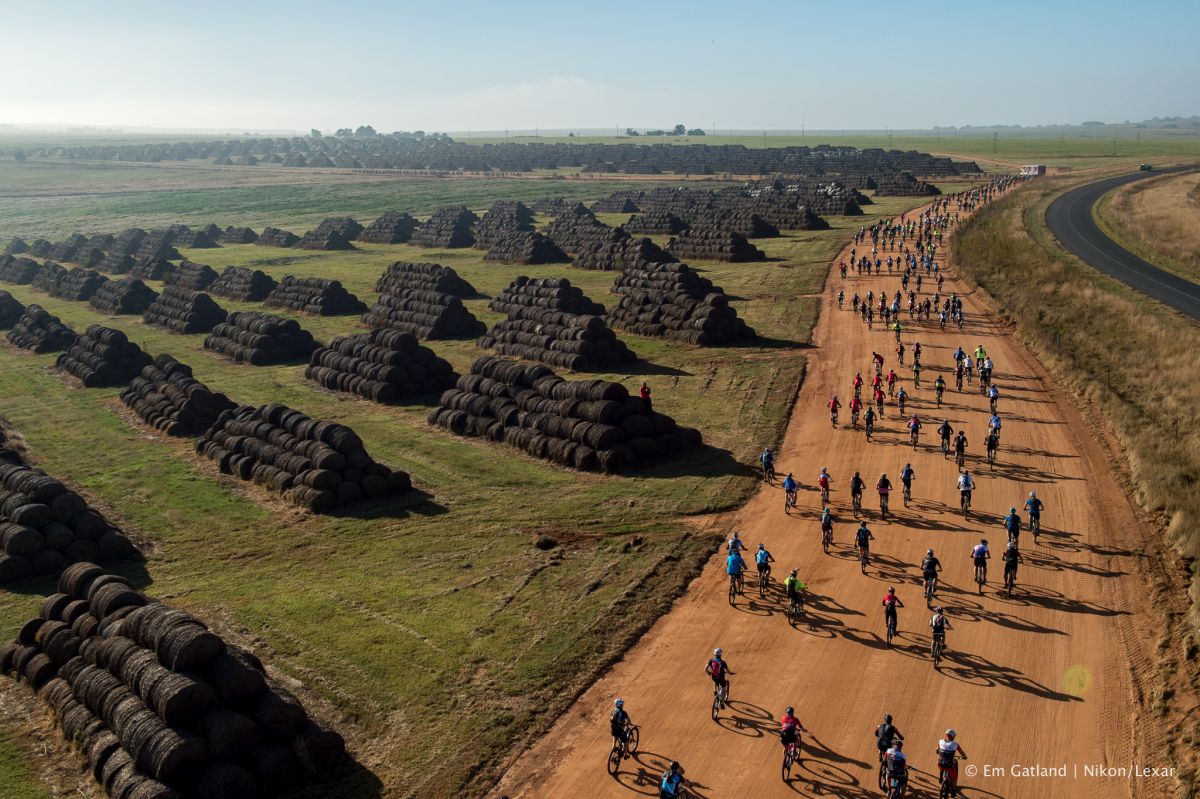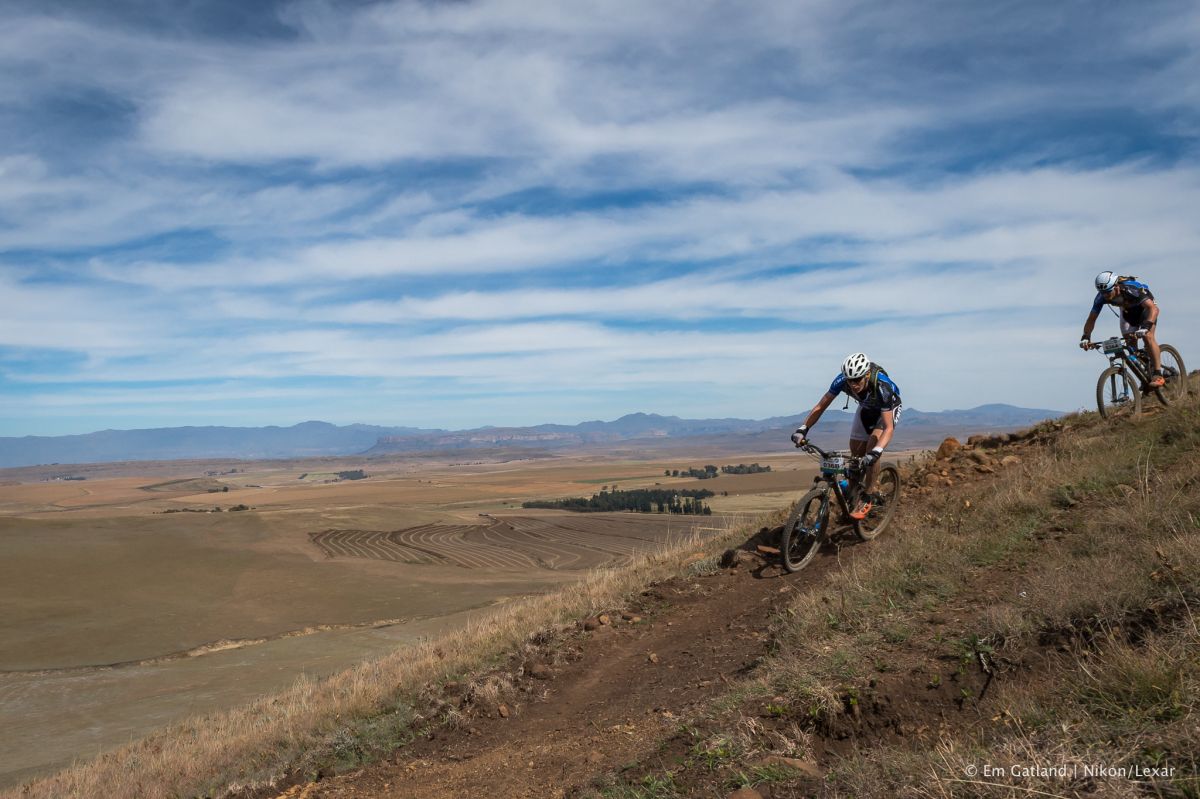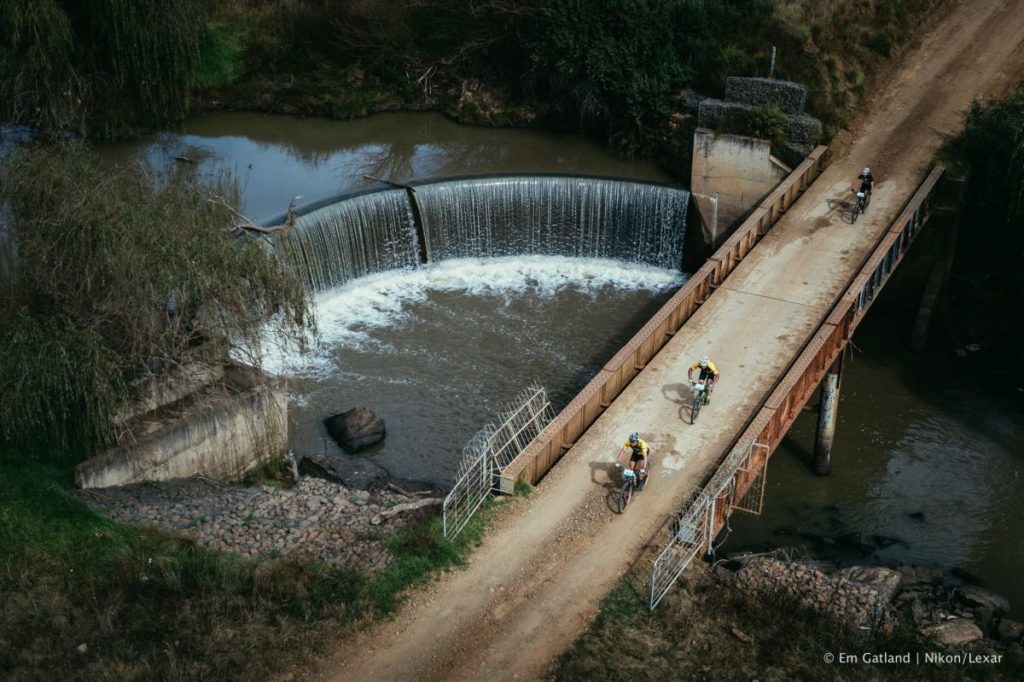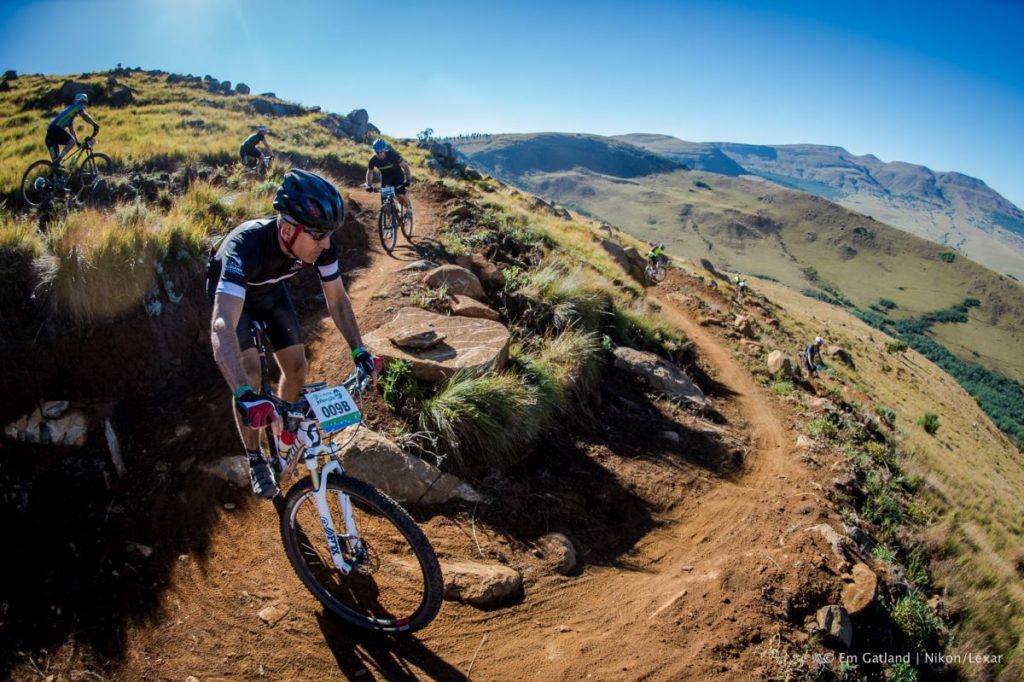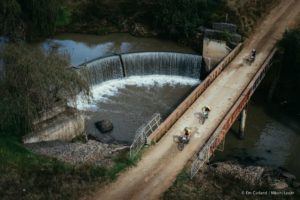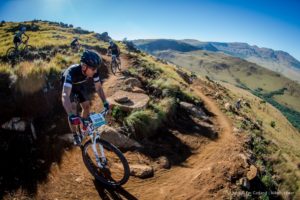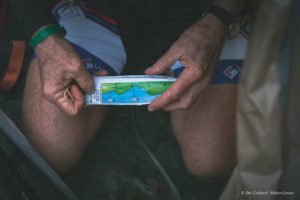My first 900 km mountain bike stage race
From three months of winter training to the sugar-cane fields, tough climbs, gnarly descents and ocean views of South Africa

by Melanie Chambers photos by Em Gatland
Just believe in yourself,” said a rider behind me. Could he see my shaking legs? Feel my pounding heart? Sense my fear? It was on a steep mountain slope, which, from above, must look like Zorro had cut the switchbacks. From the corner of my eye, I saw a woman walking. “This is beyond me,” she said. With a newfound feeling of supreme kick-assness, I continued.
RELATED: What to bring to your mountain bike stage race
Believe in yourself. With this in mind, I started flowing through the corners, aiming the front wheel with confidence, letting the brakes go – finding my groove. Finally reaching the bottom, unclipping while my leg was still shaking, I searched for the rider behind me. Gone. He’ll never know how much he helped me. Farther down the rocky descent to the gravel road, my partner in life and cycling, Paul, was waiting for me with a group of local school kids – all of them jumping and cheering me on. As I posed for a picture, the six days I had spent on my bike felt like a lifetime of vignettes and adventures.
There were three more days of the Joberg2c mountain bike stage race, which ran for an eighth time this past April. Those three days would take us to the Indian Ocean, south of Durban, 900 km away from our start southwest of Johannesburg.
I discovered Joberg2c while riding my first ever stage race, Epic Israel, in 2016. “If you liked three days, you’ll love nine,” said Ico Schutte, a South African mountain biker and paddler.
In December, I contacted Craig Wapnick, Joberg2c organizer. “Howzit, Melanie?” said Wappo, as he’s known in the local riding community. “Do you want to race or ride?” This is an important question for Joberg2c. Of the 800 riders, 80 per cent ride. “Don’t get me wrong, you still have to train damn hard, but you don’t want to miss out on the scenery.”
I asked Paul Reinis to be my partner. Paul is a racer, through and through, with a competitive spirit. Could he just ride and not race ahead? Sometimes at home on the trail, if I’m slowing him down, he’ll ask: “Are you feeling OK?” I’m warming up, damn it. Would our relationship survive these nine days?
South Africa has about 50 mountain bike stage races annually. Still, Joberg2c holds a special place in the country’s racing canon and the international circuit: “It is a journey,” said Wapnick. Tracking through private land most travellers won’t see, it’s the longest of SA’s stage races: “It’s an incredible and unbelievable way to experience South Africa on a mountain bike.”
It’s not a technical race like BC Bike Race, nor is it a strictly competitive race like the Cape Epic. “We’re not trying to break people, we’re trying to uplift them,” said Wapnick. Riders will experience various terrain from the rolling flat hills of the Free State province to the lush green area of the KwaZulu-Natal.
First run in 2010, Joberg2c is a combination of two popular stages races: Berg & Bush, by farmer Gary Green, and the Sani2c races by dairy farmer Glen Haw. Haw pitched the idea of a nine-day race to Green, which Green got behind. Haw also brought his old friend Wapnick on-board to help. The trio created Joberg2c.
RELATED: How to prepare for your mountain bike stage race
Throughout Joberg2c, communities, schools and farmers host the water stations and nightly tent villages with lavish, unlimited meals, bike washing, device charging stations, music and excellent coffee. “Our government doesn’t support these communities enough so they use the race as a fundraiser,” Wapnick said.
In January, I got in touch with Melinda Davie, the creator of The Wild Bettys (my Toronto club) and Joberg2c participant: “There really isn’t a moment when you’re not pedalling. It’s non-stop.” With only three months to prepare, I was petrified.
How to get enough mileage during a slushy winter? After much nagging, my partner got me to work effectively with Sufferfest training videos instead of lollygagging on the trainer while watching Conan the Barbarian movies. Paul had to convince me to use heart rate and power data to streamline my training and to learn how much I could suffer
Eventually, I began to look forward to the songs in videos, the virtual 20 per cent grade hills and the numbers that showed I was improving. And shockingly, I wasn’t bored. I loved watching my cycling heroes like Chris Froome tackle the hills and laughing at the cheesy Sufferfest sayings: “Sufferlandrians know how to dance on the shredded chamois of their vanquished foes.” I was getting into a rhythm, and pushing harder and harder with each training session.
RELATED: 14 top notch events to put on your calendar for 2018
By mid-February, I was in the saddle 10 to 15 hours a week, which necessitated new women’s-specific shorts. Something else I learned the hard way: women’s chamois are different from men’s.
By early March, I was only resting one day a week, getting stronger and feeling great when suddenly, my legs went flat. I had no energy. Checking my heart rate, it was unusually low. “You need a proper rest. You’ve been working too hard. Rest is as important as work when you’re in training,” Paul said. I felt deflated. My motivation waned so I began yoga and boot-camp classes. I decided to listen to Paul; I slowed down entirely for about week. Like magic, my energy returned. But by early April, anxiety was taking hold of me. Psoriasis, a blotchy and itchy skin condition exacerbated by stress, was spreading.
April arrived. After 24 hours of plane travel, a six-hour time change and a 1,677-m altitude change, we met Wapnick at the pre-race meeting. “Three things could derail you on this ride, and two involve your ass: crashes, diarrhea and bum sores,” he said. Wapnick also gave the large group of mostly middle-aged athletes a lesson in sanitary practices and rules to avoid stomach problems.
On Day 1, Paul and I waited at the start line groggy, cold and pasty-mouthed. We kissed and began our longest day of mountain biking, so far: 114 km. With shoulder-toshoulder riders on the slippery gravel road and red dust swirling up, I could hardly see Paul’s orange helmet ahead. The first day was a neutral day, but the first water station at 30 km felt like Christmas morning. At the station, school girls in plaid-kilt uniforms with wooden boxes around their necks asked us in their plummy South African accents: “Would you care for a koeksister ?” Imagine fried dough plunged into ice cold water (which later increases the syrup absorption), and then soaked in syrup.
“You will gain weight on this race,” said Chris WestgarthTaylor. He was on his third Joberg2c attempt. On the second last day of his first attempt, he dislocated a shoulder and was airlifted out. The following year, he was injured on a training ride before Joberg2c and had to cancel his race entirely. With an entourage of friends to see him through the 2017 edition, he also had another mission. He’s a pediatric surgeon. His charity, Surgeons for Little Lives, had 40 riders fundraising. Throughout the race, it was easy to spot the blue surgical scrub hats over their helmets.
After drafting on a gravel road for hours, we hit a festive water station. A little girl offered to lube my chain. Another sprayed me down in sunscreen. Over an open flame, a farmer in a straw hat was braiing boerewors (barbecuing a traditional farmer’s sausage). That night, during a steak dinner, we struggled to stay awake as we watched video highlights of the day.
By the end of Day 2, with 90 km riding, I’d already succumbed to bum blisters. During seven hours of riding on Day 3, I invented new positions – sidesaddle, resting on the top tube – anything to avoid sitting. Coming into the first water station, I noticed our neighbour’s hands stuffed down his shorts applying chamois cream. “Handshake?” he asked with a dusty-faced grin.
By afternoon I noticed another mess: engorged sunburn blisters behind my knees. That night, a nurse wrapped them in gauze and tea-tree oil. For three days, I wore leg warmers in 30 C-plus heat.
The scenery was a distraction from the aches and pains. As we left a quiet riverside singletrack on Day 3, the trail opened up to a mountain shaped like a peak of meringue on a pie, and a 3-km climb up Mount Paul. Behind my Paul, a lone cyclist tucked in. “I was signed up last year but had to drop out because of the cancer treatment,” said Malan de Villiers, a bioengineer from Pretoria. Off and on during the climb we revealed our lives. “Is this a good pace?” I asked de Villiers. Paul had scooted ahead. “Perfect. Lead us up!” said de Villiers. Eventually another rider tucked in behind de Villiers. Heads down, churning the pedals, we rode in silence. Reaching the peak, we finally talked face to face and took a picture with a view of the Drakensberg Mountains. We would ride alongside these beauties for days.
On Day 5, the trail cut across a canyon plateau. Great Wall My China felt like riding on the edge of the world. At the top, looking down on the criss-crossing switchback downhill, I did something I would never do in a race: I stepped off my bike and watched the riders glide back and forth down the mountainside. With dust kicking up, it looked like cowboys and cowgirls on mountain bikes descending into the setting sun.
Later that day, we hit a spongy forested trail. (It was hard to believe we were in an arid dusty canyon the day before.) Painted on a rock was “Buckle up!” I led a group of riders into a pine forest of berms and jumps. “Kill it! Yeah!” yelled the rider behind me. Riders took turns hooting and hollering. “Let the brakes go,” I said to myself. I was getting air and launching off the whoops – manoeuvres I wouldn’t try back home. When the trail spit us out of the forest, I felt like fist pumping the air as Judd Nelson’s character did at the end of The Breakfast Club.
For nine days, time moved like an accordion. Hours trickled by painfully on the seemingly endless dusty gravel roads and bumpy farmers fields, while surprises like a bagpipe player on the top of a hill or two girls singing and serving ice cream at a water stop were fleeting. But it was the blessed sections of singletrack (250 km) that finished entirely too fast.
The race routine was also becoming second nature: wake in darkness to AC/DC’s “Thunderstruck” blasting throughout the camp, pack bags, eat, apply chamois cream, gather bike, lube chain and grab water bottles. With everyone in staggered starts according to ability, faces were also becoming familiar in our group. We had started in the E Pack, about the middle of the field of 800 riders. But, we eventually moved up to D. I credit our climbing prowess: Paul and I love hills and Day 5 and 6 were mini- Everests. Imagine 30 km climbing with a gradient approaching 20 per cent. A cyclist in front stopped pedalling and immediately fell over. From behind me: “I’ve never seen a woman with legs like that!” That was de Villiers. I smiled and picked up a smidgen of momentum with the ego boost.
Day 8. Could it be almost over? Was I happy or sad? It had become an all-consuming world, where my arse was constantly sore, but I had never felt stronger, faster and more connected to my fellow riders.
RELATED: Training for a nine-day mountain bike race in 12 weeks
Even though Day 9 was another neutral day, we still had to ride 83 km. But at midday, I had a fright: as I crested a hill, my chain had snapped. The thought of coming this far and not finishing because of something preventable was crushing. I’d been shifting poorly all week, but that day I learned a lesson about listening to one’s partner and bike mechanics. (Paul taught me how to reattach the chain with a chain tool.) We carried on through tall stalks of sugar cane swaying in the wind, leaves slapping our faces, until we finally reached the ocean. The sight of the blue water encouraged us to start pedalling faster. Finally crossing the finish line, we were handed bottles of champagne. After many hugs with our new friends, Paul and I took the champagne to the beach, toasted our happiness and then jumped into the warm Indian Ocean. We flopped in the water like children.
